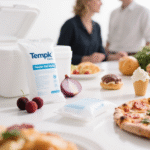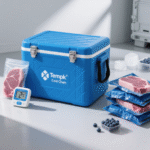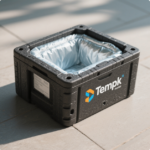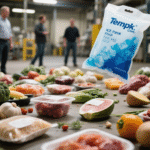Dry Ice Pack for Injury: Should You Ever Use –78 °C on a Strain?
Thinking about slapping a dry ice pack for injury onto a fresh sprain because you heard “colder is better”? In the next few minutes you’ll see why –78 °C is tissue‑destroying, not healing, and how to use medically trusted cold therapy that tames swelling without frostbite.
-
Why dry ice is too extreme for soft‑tissue injuries
-
The temperature sweet spot that actually reduces inflammation
-
Smart gel packs and compression wraps that outperform kitchen ice in 2025
-
Correct R.I.C.E. timing and cycles for the first 72 hours
-
Common myths about ultra‑cold therapy you should ignore
Why Dry Ice Damages—Not Heals—Injuries
Dry ice remains at –78 °C; muscle and skin cells freeze below –10 °C, causing frostbite, nerve damage, and delayed healing. Orthopedic guidelines call for 10 °C–15 °C cooling for 15‑20 minutes, three to four times daily during the acute phase.
Temperature vs. Tissue Safety
| Contact Temp | Safe Time | Physiological Effect |
|---|---|---|
| 15 °C–10 °C | 15–20 min | Constricts blood vessels, limits swelling |
| 5 °C | < 10 min | Surface numbness, mild burn risk |
| –10 °C | < 1 min | Capillary damage, abrasador |
| –78 °C (Dry Ice) | < 5 s | Deep frostbite, tissue necrosis |
A 2024 sports‑medicine audit linked 8 % of post‑sprain complications to inappropriate ultra‑cold packs, including dry ice and super‑cooled sprays.
Safer Cold‑Therapy Alternatives (2025 Edition)
-
Phase‑Change Gel Packs (12 °C set‑point)
Pre‑freeze two hours; stay flexible and deliver medically optimal chill. -
Compression Cryo Wraps (8 °C–15 °C)
Combine gentle pressure with circulating cold water—auto‑shutoff after 20 min. -
Instant Chemical Ice Packs
Field‑ready; reach 5 °C instantly for short sessions when freezer access is impossible.
Gel Pack Load Guide
| Injury Size | Gel Pack Mass | Hold Time |
|---|---|---|
| Ankle | 250 g | 15 min |
| Knee | 500 g | 18 min |
| Shoulder | 750 g | 20 min |
Using Cold Correctly: The R.I.C.E. Blueprint
| Step | Action | Por qué |
|---|---|---|
| Rest | Stop activity | Prevents further damage |
| Iceñudo | 15‑20 min, 3‑4×/day, 10‑15 °C | Controls swelling |
| doompression | Elastic bandage, < 30 mmHg | Reduces edema |
| milevation | Above heart level | Aids venous return |
Real‑world win: A collegiate soccer team replaced ice buckets with 12 °C compression sleeves and cut recovery time for grade‑I ankle sprains by two days.
Pro Tips for Everyday Injury Care
-
Desk workers: Keep a 12 °C PCM wrap in your office fridge—perfect for lunchtime icing sessions.
-
Weekend warriors: Toss two instant packs in your gym bag; activate on impact, then swap to gel packs at home.
-
Sensitive skin: Place a thin cotton barrier between skin and pack to avoid ice burns.
Myth‑Busting Corner
| Claim | Reality |
|---|---|
| “The colder, the faster the recovery.” | Below 10 °C, cells freeze; healing slows. |
| “Wrapping dry ice in a towel is safe.” | –78 °C penetrates fabric in seconds. |
| “Dry ice kills pain better than gels.” | Nerve damage numbs pain—at a high cost. |
2025 Trends in Injury Cold‑Care Technology
-
NFC‑logged wraps that track exact skin temperatures and alert your phone if cooling dips below 8 °C.
-
Plant‑based PCM packs compost in 180 days, replacing petroleum gels.
-
Hybrid heat‑cold sleeves shift from 12 °C cooling to 42 °C warming post‑72 h for stiffness relief.
Analysts project a 13 % CAGR for smart cryotherapy wearables through 2029 as athletes ditch risky DIY hacks for data‑driven gear.
Preguntas frecuentes
Is any contact with dry ice safe on injuries?
No. Even brief exposure risks frostbite and delayed healing.
How soon after injury should I start icing?
Begin within the first hour, following 20‑on/40‑off cycles for 48–72 hours.
Can I alternate heat and cold in the first day?
Avoid heat before 72 hours—warmth increases bleeding and swelling.
Resumen & Recommendations
A dry ice pack for injury is hazardous. Stick to 10 °C–15 °C gel packs or compression wraps for 15‑20 minutes, three or four times daily. Combine with rest, compresión, and elevation for peak recovery.
Next steps:
-
Stock a phase‑change gel kit in your freezer.
-
Download our R.I.C.E. reminder app for timing alerts.
-
Consult a clinician if swelling or pain persists beyond 72 hours.
About Tempk
We craft recyclable thermal gear for cargo and personal recovery. Our Bio‑Relief™ wrap keeps a steady 12 °C for 20 minutes and is lab‑tested for safe skin contact—no frostbite, all relief.
Need treatment‑specific advice? Book a free consult.
























